- Water For Everyone – an initiative of Water Charity
- Water for Everyone - Madagascar
- Mahajoarivo Well Project - Madagascar
- Tsivangiana Well Improvement Project - Madagascar
- Antanandava, Anamboafo, and Marolamba Well Project - Madagascar
- Amindratombo School Well Project – Madagascar
- Antsikory Well Project - Madagascar
- Amindratombo School Latrine Project – Madagascar
- Village Well Program Phase I - Madagascar
- Ambavala Well Project – Madagascar
- Ambodisambalahy and Anjangoveratra Well Improvement Project - Madagascar
- Antsakoana Water Pump Project – Madagascar
- Mandritsara Tree Nursery Project - Madagascar
- Andrenilaivelo Well Project - Madagascar
- Amporoforo Clinic Shower Facility - Madagascar
- Anjiro Well and Dam Project – Madagascar
- Faratsiho Well and Pump Project - Madagascar
- Morarano Well Project - Madagascar
- Marolambo Water Rehabilitation Project – Madagascar
- Anketrakabe Pump Project - Madagascar
- Ambatomainty Water Project - Madagascar
- CATJA Water Project - Madagascar
- Tsivangiana Composting Latrine Project - Madagascar
- Ampasimbola Well Project – Madagascar
- Morarano Chrome Water Pump Project - Madagascar
- Amboromana Well Project - Madagascar
- Zanabahona I Water Project – Madagascar
- Mitsinjo Bathroom Project - Madagascar
- Ambonivato Biogas Toilet Project - Madagascar
- Andonaka Well Project - Madagascar
- Morarano Public Latrine Project - Madagascar
- Analalava Special Community Reserve Well Project - Madagascar
- Clinic and Community of Ansampanimahazo Well Project - Madagascar
- Analalava Well Tour – Madagascar
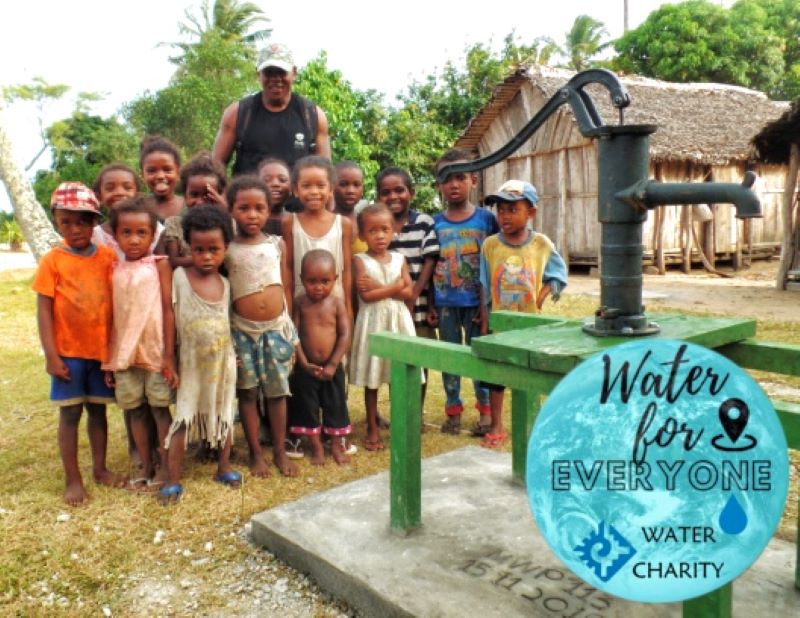
Coming off recent success in The Gambia and Liberia, Water Charity is embarked on another Water for Everyone Project in Madagascar. We have been active in Madagascar from early on in WC history, having sponsored many dozens of projects in recent years and touched hundreds of villages. Our primary intervention there has been in the rehabilitation of broken wells first, and the drilling of new wells where necessary.
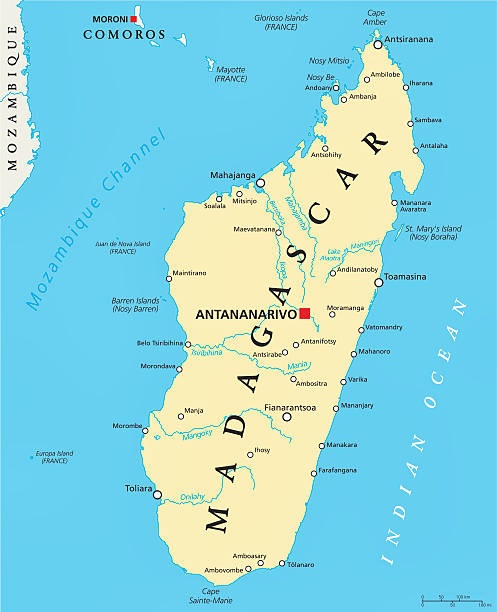
Madagascar is well-suited for a Water for Everyone Program. Only half the population has access to clean water and much of that population lies in rural communities. Most rely on subsistence farming and fishing for their livelihood. Forty-three percent of adults lack proper nutrition and forty-eight percent of children under five suffer from stunted growth. There have been other projects to address water availability in cities and larger villages, but the rural populations still have a long way to go, and this is where our focus lies.
The challenges are as varied as the mini continent that forms Madagascar. The center of the country is formed by mountainous highlands dominated by igneous basements, making the search for subsurface water quite difficult. The coasts are rimmed with sedimentary rock and carbonates and are slightly more conducive for water drilling. The north and east are largely semi-tropical while the south and southwest are arid. It seems that climate change has made conditions worse in the south where water is lacking even for agricultural purposes, and malnutrition and starvation are widespread.
Many attempts over the years have been made to mitigate the water problem. There are literally thousands of broken wells across the country that have fallen into disrepair. One objective of this project is to find and identify these wells, assess their potential, and design programs to put them back in service. Our partners, local residents of the various regions, are our force on the ground to collect these data points. Water Charity uses GIS data and our Geospatial analysis capabilities to identify needs, and gaps in infrastructure, and design specific and targeted programs to get water to those in need. It is expected the entire project could take a few years, but we are confident that all rural villages can be provided with at least one working well and given the skills to maintain them.
Our local Malagasy partners and The Madagascar Water Project (MWP), have extensive connections and knowledge about the country, the languages and dialects spoken, and are a key piece of the puzzle for this ambitious program. We have worked with them for many years, drilling dozens of wells and repairing countless broken ones to provide clean water to thousands of people. This program has begun along the east coast and will expand to include rural regions all over, with the goal of eventually including the entire county. We will not deal with cities and the larger towns for this B2B effort, as there are existing infrastructure issues and the problems are entirely different. WFE Madagascar is solely focused on the rural villages, at least for now.
Goals and Methods of Water for Everyone
The Madagascar Water for Everyone Project is designed to achieve the goals of the United Nations Sustainable Development Goal 6.1 and the Plan Emergence Madagascar Priorate 29.
- United Nations Sustainable Development Goal 6.1: By 2030, achieve universal and equitable access to safe and affordable drinking water for all.
- Plan Emergence Madagascar Priorite 29 – Garantirl’acces universal a l’eau potable (French is a main language for government there)
The Project combines the latest technology in satellite mapping with an extensive ground-based data collection effort. The Program will conduct inventories and is documenting existing water infrastructure. We are assessing functionality and adequacy to the populations served and can thus identify under-served populations where they exist. Population data, water-related health data, agricultural and irrigation data, and water infrastructure and water quality data has been collected from local officials when available, and we will continue to work with these agencies as closely as we can.
All our projects (in this program and out) involve extensive documentation. Well location data is recorded using GPS-enabled devices, this data is combined with various survey and government-provided information and cross-referenced with other aid groups and NGOs. We have webpages put up regularly (see page bottom for links) and update them with new info and media from the field. While this is usually done with incredible speed, we can not always keep pages up to date in real-time and it may take us some weeks to post recent work.
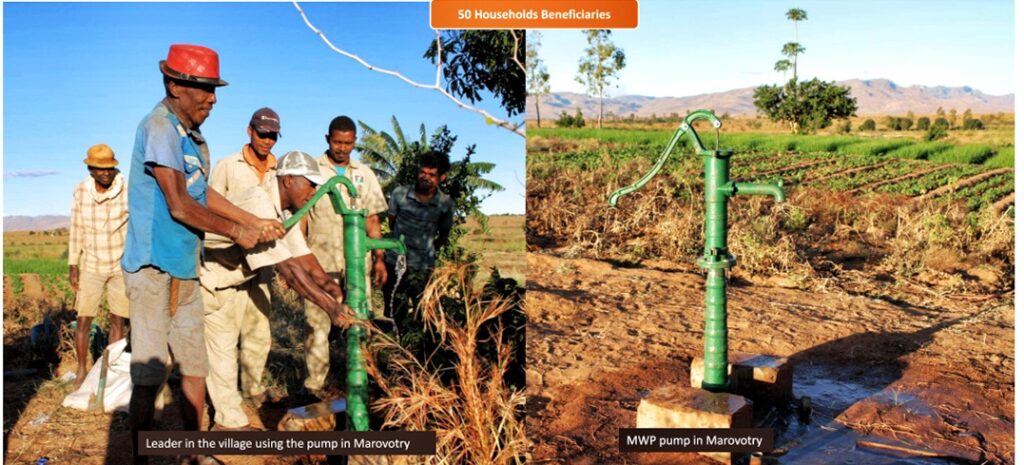
Water Charity integrates population, infrastructure, health, and other data collected on the ground into Geographic Information System (GIS) map-based platform including ArcGIS and Earth Engine. This makes it possible to 1) identify and quantify gaps in water infrastructure; 2) design specific and targeted projects to improve clean water access 3) put them in a format that can be presented to potential sponsors and operators and 4) track their impact over time. Projects coming up include newly drilled wells, repair of existing wells, and the repairs, maintenance, and upgrades of a larger infrastructure. Some areas will be prioritized based on their specific needs.
The Project began in the Region of Antsinanana and continues into other Regions of Madagascar on pace.
The Madagascar Water Project: an overview
Since 2015, WFE Madagascar & the Madagascar Water Project have drilled about 200 water wells in about 80 rural villages, providing clean water to an estimated 100,000 people. Starting around Antsinanana, the work has migrated to the south over time and the well drilling work can now be found as far south as Mananjary. To aid in this effort, WC funded the purchase of a dedicated well drilling rig over the summer of 2022. This new rig can be expected to function for many years to come with minimal maintenance and should increase the ability of MWP and the WFE program to aid the people with new wells, deepening existing wells, and even clearing debris that has come to block wells that otherwise should be functional.
We have also started a well repair program in the drought-stricken south to fix some of the thousands of broken wells located there. These well repairs have been our bread and butter in the past. and will continue to be a major part of what we do there. After all, fixing a broken well is nearly always more efficient than drilling a new well and installing a brand-new handpump.
Like many of our partners around the world, MWP is small, lean, active, and impactful. The photo below was taken in 2018 during one of our joint ventures that included the village of Salehy. This is the same core group that has supported our Water for Everyone Program all along the way, and will continue to lead the way on the ground. (note their cool Water Charity T-Shirts).
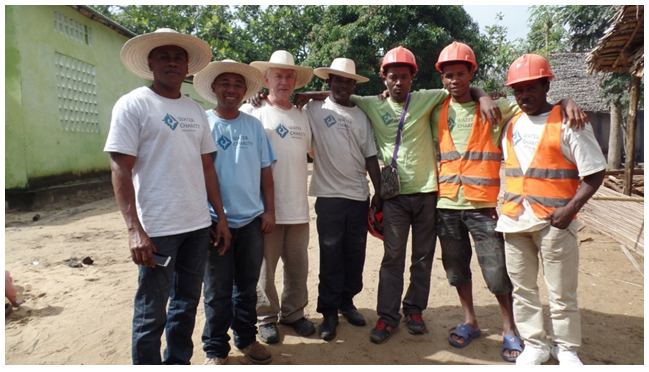
Except for Director, Frederick Rittelmeyer (3rd from left above), who works as an unpaid volunteer, the entire staff is Malagasy. As the photo shows, they are quite proud of their association with Water Charity, and it has been mutually beneficial for all. The gentleman in the foreground, Hilaire Razandrafely is the MWP Project Manager for the Madagascar Water for Everyone Project. Photo, Salehy 2019.
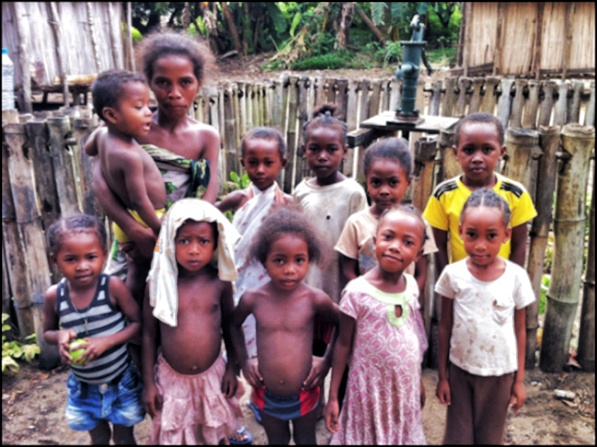
The Madagascar Water Project drilled its first well in the village of Andovoranto in 2015. That well is shown in the photo left and is still working today. We remain committed to the villages it serves and provides maintenance training, repairs, and spare parts for its wells. If the well fails, which occasionally happens, the MWP drills replacement wells when needed. Photo, Andovoranto 2015.
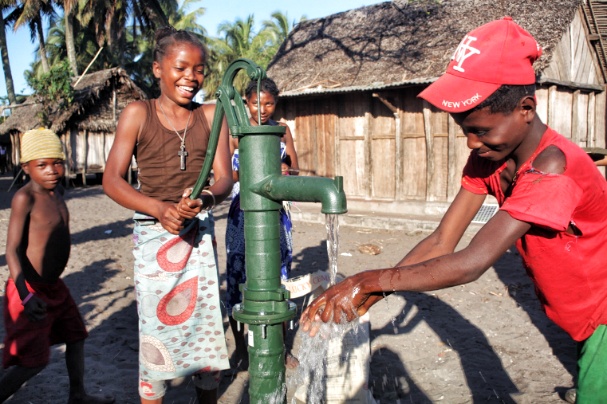
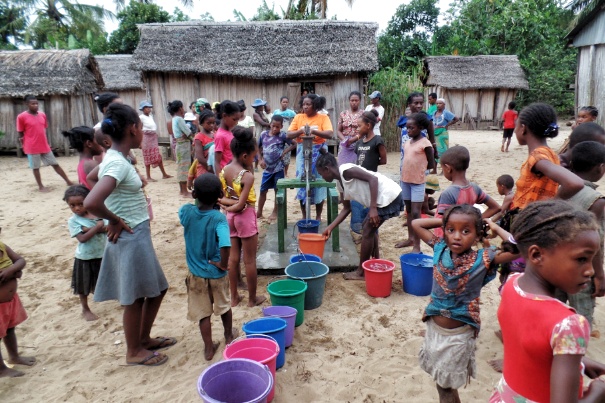
So far, WC has drilled most of its wells along the east coast, along an intra-coastal waterway known as the Pangalana Channel. To many, the area looks like paradise, but many villages had no access to clean water, which has a profoundly negative impact on the health of those living there. With the help of the MWP, the area at least has taken a small step forward into the 20th Century.
Due to the amenable conditions, we can use hand augers and slide hammers to build wells. In most cases, this takes only a few hours. Standard pitcher pumps are used and can produce at rates up to 25 liters/minute from depths to 7 meters.
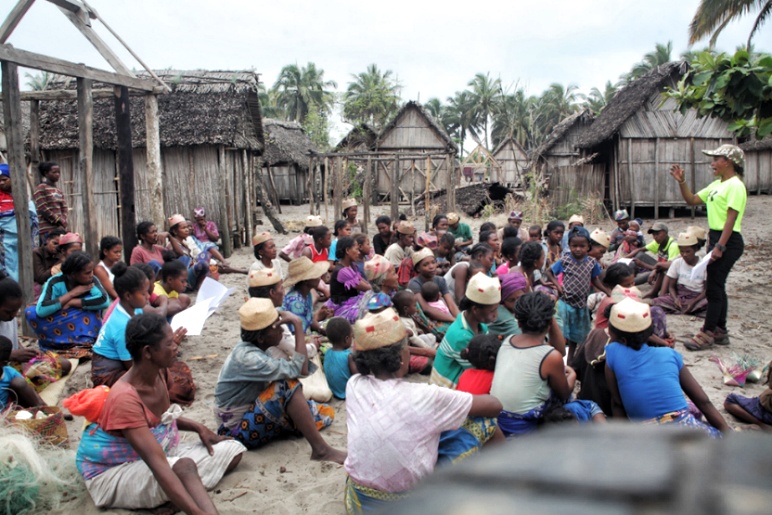
The Project provides community-based water wells, managed by Well Management Committees. The MWP provides guidance but ultimately rules, hours, and fees (if any) are determined by the committee.
Effective self-management is key to sustainability and is often more difficult than drilling the well. The line between assistance and dependency is as thin and delicate as a piece of thread.
MWP Logistics
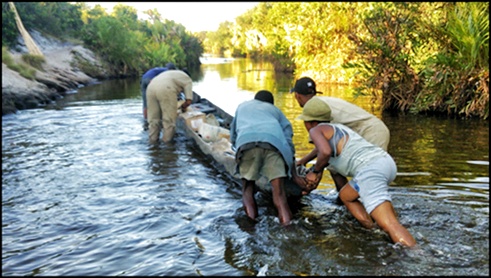
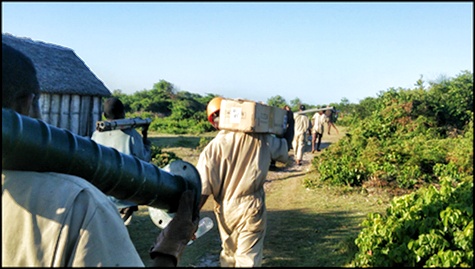
One of the biggest challenges working in Madagascar is logistics. Roads are in poor repair and often nonexistent even when they appear on a map. The Water for Everyone Project will have to overcome these challenges even more. One can choose where to drill wells, but the mission of the Water for Everyone Project is to go everywhere.
MWP History
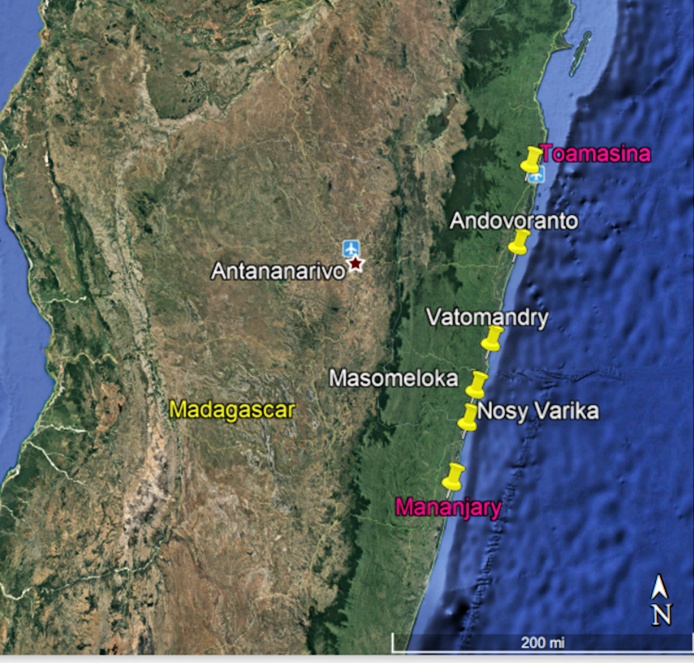
The first wells began drilling in the village of Andovoranto in 2015. The work migrated southward every year, eventually moving past the village of Mananjary in 2020.
Water Charity believes that maintenance and repairs are as critical to the program as newly drilled wells. These long-term relationships are more efficient, and create less oversight and maintenance, and, in the end, leave the communities with better, more efficient, and equitable water management.
Well Repair Program in Southern Madagascar
In 2022 WFE Madagascar began a large well-repair program in southern Madagascar. The entire southern section of the country has suffered from extreme drought for more than 10 years. Not only does it affect water availability, but it has also caused widespread famine. Malnutrition and starvation are everywhere.
Thousands of water wells have been drilled there in the past few decades. Although most are now broken, some are still capable of being repaired to provide clean water, any water to those in need.
The map below shows the current area of focus in the District of Betroka.
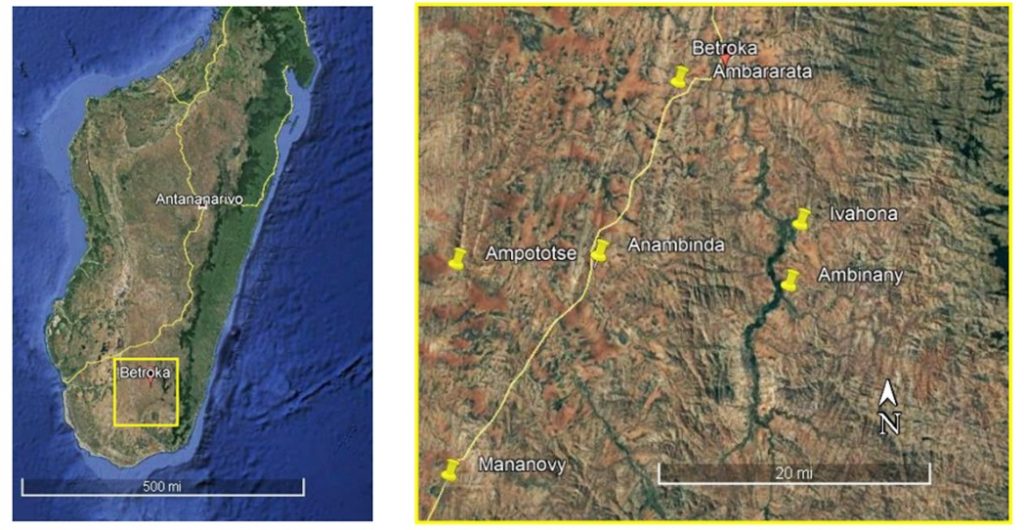
Some wells are conventional Indian Pumps that need routine repairs or have been victims of theft such as the well below in Anabinda.
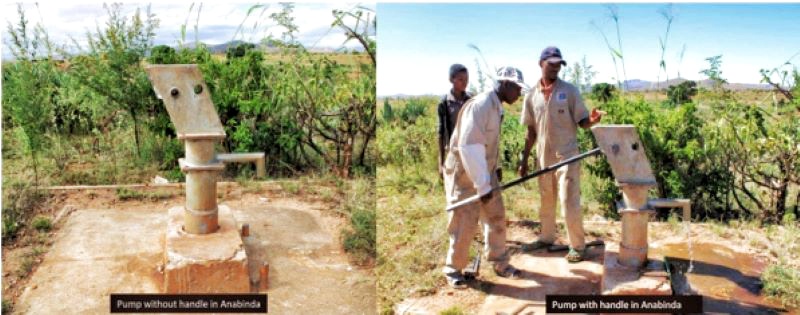
Other broken wells exist as holes in the ground. The project has installed our conventional pumps onto these wells and successfully brought them back into production. They are used as much for agricultural purposes as they are for human consumption. Each well is saving lives and improving the quality of life for many.
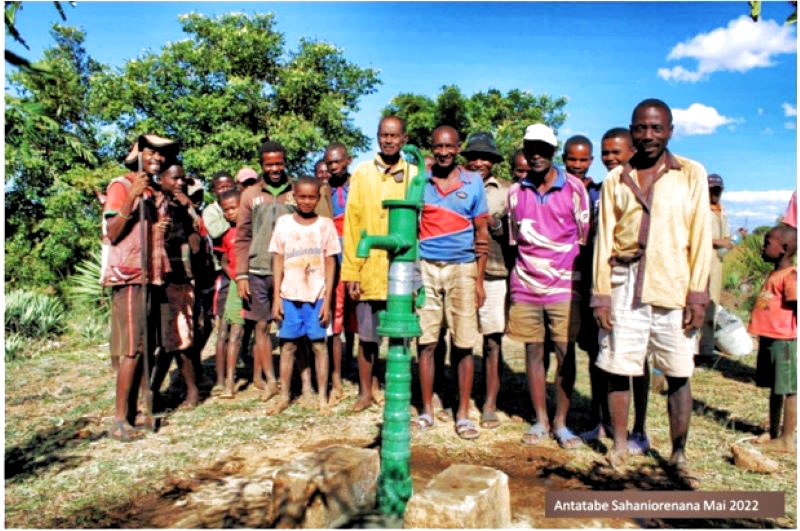
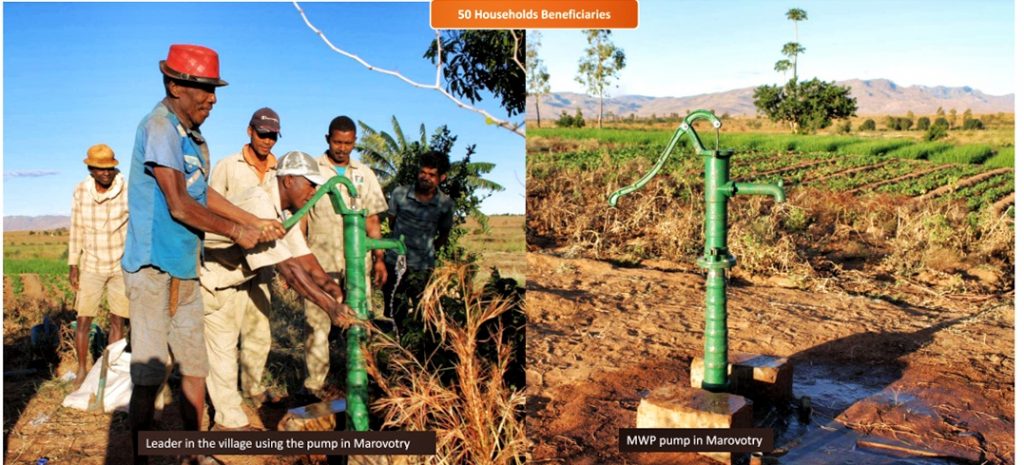
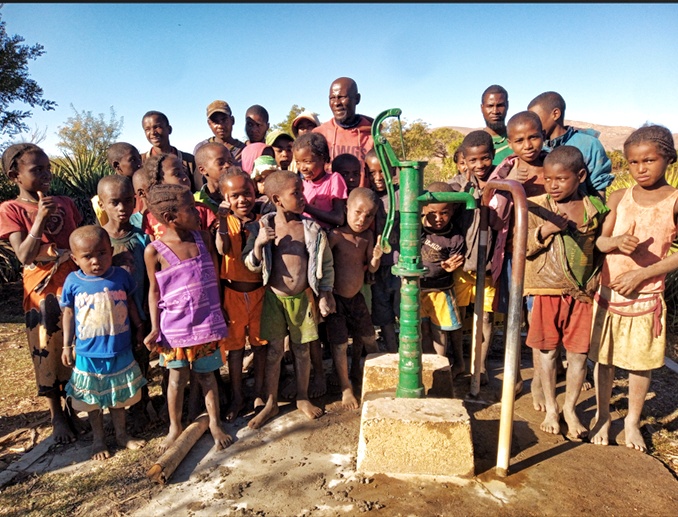
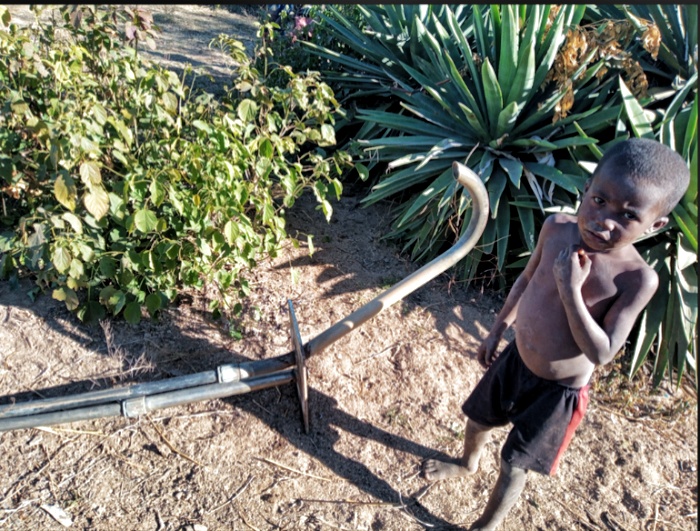
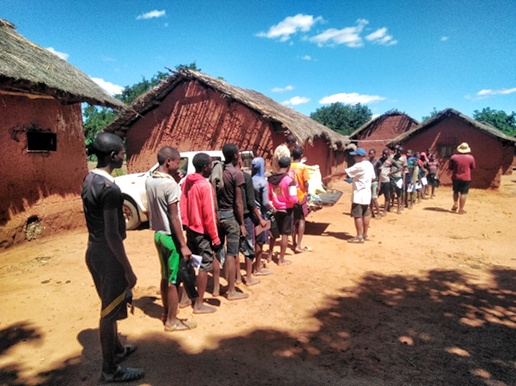
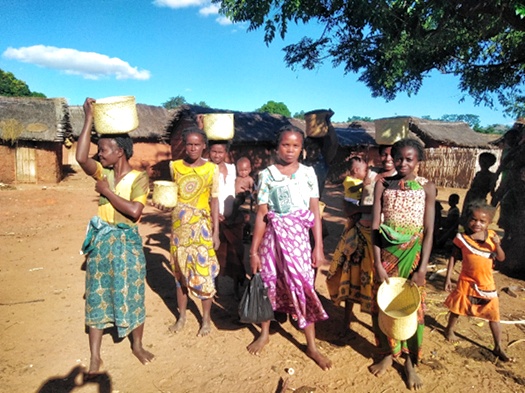
Water access is often a key component of famine. On a trip in February 2021, we deviated from our mission and distributed 350 kg of rice to a few villages that hadn’t eaten in weeks. The World Food Program, USAID, other NGOs, and the Madagascar Government have since come in to provide more assistance.
Conclusion
There is so much to do in Madagascar that a systematic, thorough, complete, and scientific approach is the best way to assess the needs, design solutions, and provide relief to the many millions still in need of clean water. The Water for Everyone Initiative is a significant move in that direction.
Join Us
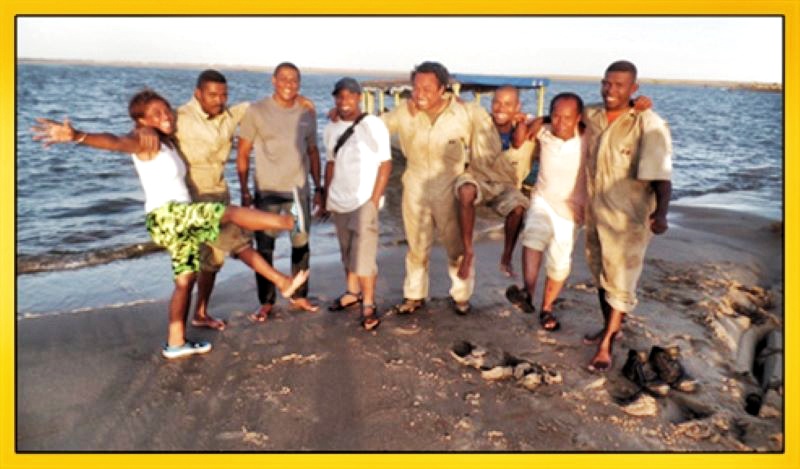
List of Water Charity’s Past Madagascar Project Pages:
13 water wells were drilled in six villages that now provide clean water to over 15,000 people. The project area is south of the Mangoro River (Salehy), through Masomeloka to Nosy Varika and beyond, moving into the remote area where the distal ends of the Regions of Antsinanana and Fianarantsoa meet.
Built a community well at the school in Andrenilaivelo, a livestock and farming community of approximately 250 people located in the central highlands of Madagascar.
Built 2 latrines at the primary school in the village of Amindratombo. Amindratombo is part of the community of Sahambavy, located in the southern highlands of Madagascar. The project will benefit 200 students.
Build a well at the primary school in the village of Amindratombo. The well will be used to provide drinking water for the students. Amindratombo is part of the community of Sahambavy, located in the southern highlands of Madagascar. The project will benefit the 200 students plus indirect beneficiaries numbering about 1,500: 1,700 total.
Repair and improve the well at the Maternity and Health Center in the community of Ansampanimahazo is located 9 km from its district Faratsiho in the northern highlands of Madagascar. The population consists of approximately 15,000 people spread across 12 villages.
Build 4 wells in the Amboromana district of Vohemar, Madagascar. There are currently 360 families living in the area, with a population of 1,836 people.
Purchase and install 1 water pump to expand the production of rice in the community. Morarano Chrome is a town and commune in the Eastern part of Madagascar. Over 150 people who work in the fields, and their families, will benefit from the project.
Built 3 wells and 1 dam in three neighboring fokontanies (neighborhoods) of Anjiro: Mahatsinjo, Antanetibe, and Ambilobe. Anjiro is a rural community located in the central highlands of Madagascar. It has a population of about 15,000 people.
Replace 1 broken handpump at the site with a sealed well lined with concrete rings, and an electronic pump for the Special Community Reserve of Analalava, a protected rainforest on the east coast of Madagascar, owned by the local community. This project immediately benefitted 150+ people and has since benefitted thousands of tourists.
Build 2 new public latrines, with lined and displaced pits and ventilation. The facilities will be made available for use by the students and villagers.of Morarano, a rural village located 12 km southwest of the beach town of Foulpointe on the east coast of Madagascar. About 150 people live in the village center. However, the presence of an elementary school means 270 students come in from the surrounding hills on a daily basis: a total of 420 people.
Build 1 public biogas toilet for the community that uses human waste as a valuable resource that can be converted into two products: (1) gas for cooking and (2) fertilizer. The project was located in the beautiful coastal community of Ambonivato, about 8 miles outside of Tamatave, the second largest city in Madagascar. Though it is close to the city, the village of 750 people is still a very poor and rural village.
1 bathroom facility with 3 toilets, 3 urinals, and 3 sinks for Association Mitsinjo, an association of local guides. Mitsinjo is located 2 km from the village of Andasibe, but its impact zone is much larger. It is the manager of the Torotorofotsy wetlands, a Ramsar site, as well as the Analamazaotra forest station. The facility will benefit the association through the 3,000+ tourists that visit annually.
1 new, high-quality, composting latrine behind the clinic which can be used by all of the approximately 300 patients, health workers, nurses, and the doctor in Tsivangiana, a rice-farming and fishing village near the east coast of Madagascar. There is a major water sanitation problem, with a couple of stagnant streams used for everything from bathing, to washing clothes, to washing dishes, to collecting water for cooking and other household uses.
1 new well in the village of Ambavala, located on the tropical and beautiful northeast coast of the island nation of Madagascar. This rather large village of nearly 300 people depends on only one well for all of their daily water needs.
1 refurbished non-functioning well. Mahajoanivo is a small rural village in the Central Highlands of Madagascar. Mahajoanivo has 211 residents; most are farmers.
Install 6 pumps in existing wells for use in 6 different cooperatives, including the rice cooperative, garden cooperative, and women’s gardening group, to irrigate their crops. The cooperatives are located in Anketrakabe, a village of approximately 1,200 people located 47 km from Diego.
1 tree nursery to create food security, increase the available water supply, and provide economic benefits to the 300,000 people in Mandritsara, a city and commune in northern Madagascar.
1 rainwater harvesting system and 3 systems to remediate flooding problems for the three largest dormitories on the Le Centre d’Accueil et de Transit des Jumeaux Abandonné (CATJA), an orphanage for 125 abandoned twin children. The orphanage is located in Mananjary, a seaside town in southeast Madagascar that is home to nearly 30,000 Malagasy whose livelihoods are very much integrated with their natural surroundings.
5- Day Permagarden Staff and Volunteer Training and Training Design Creation; Peace Corps Madagascar requested assistance in the creation of a thorough Training Design and Evaluation Process that will guide the sustainable agriculture and nutrition security work of current and future Peace Corps Volunteers.
13 wells provided to the 6 Fokotany (Villages) of Masomeloka, Antaniambo, Sohihy, Ampanotoana, Salehy, Andrianotsara, serving 15,000 people.
1 shower facility to serve the Amporofor Clinic, which serves 12,543 people. Access to a shower with clean water and soap will reduce the risk of infection to the person, as well as reduce contamination by viruses and bacteria in the clinic area.
Improve 4 wells, including the installation of 2 new pumps for Ambatomainty, a rural community of about 10,000 people located in the Alaotra Mangoro region, also known as the ‘rice basket’ of Madagascar. For water, families were long forced to rely on a river that has turned red from mud and erosion.
1 well built between the local elementary school and the community center of Antsakoana, a small village south of the town Amparafaravola located in the Eastern part of Madagascar; well will benefit roughly 350 people.
Improve 2 wells for the 1,000 people of Tsivangiana, who live along the east coast of Madagascar, separated from the Indian Ocean by about 20 kilometers of degraded rainforest. After the well broke, for the past three years the people have been fetching water from the stream.
1 well and 1 new pump for a second well; the project recipient facility, Centre Hospitalier de District (CHD), benefits 2,000 people per month who attend the health facilities.
2 wells were built for the village of Andonaka, located on the east coast of Madagascar, 12 km west of the commune and district capital Nosy Varika and accessible only by boat. No potable water exists for the 1,270 residents of Andonaka; all water is drawn from the Sakeleneoa River which also serves as a bath, laundry, and dishwashing source as well.
1 well and a reconstructed aqueduct provided to the mountain town of Imito, located 224 km south of Antananarivo, the capital of Madagascar. Zanabahona is one of the largest communities in Imito with a population of 2,300. Project conducted by Peace Corp Volunteer and local NGO.
Purchase and installation of a water pump for use by the members of Fanilo, the local farmers association in Antsakoana, a small town north of the town Amparafaravola, located in the Eastern part of Madagascar. The project gave the water control needed for the planting of currently unused rice fields. The project benefitted 280 people who work in the fields and their families.
1 well provided to Morarano, a rural village located 12 km southwest of the beach town of Foulpointe on the east coast of Madagascar. About 150 people live in the village center and 270 students come in from the surrounding hills on a daily basis: a total of 420. In a polluted pool, people bathe and wash laundry and dishes before taking the water home to cook and drink. The work was conducted by a school teacher with experience in digging lined latrines, a Peace Corps Volunteer, and a motivated health worker who lives in the village.
3 wells built in three different communities in northern Madagascar, carried out under the direction of a Peace Corps Volunteer and a local NGO ARES, which has organized teams to build over 50 wells. The three towns are in the commune of Anjangoveratra, district of Sambava: Antanandava, Anamboafo, and Marolamba, with a total population of 3,419, and no wells. Residents have to get their water from rivers, streams, and even rice paddies, which are polluted by cow and human waste. Several deaths in the towns in the past year have been attributed to water contamination.
4 wells built in the Amboromana district of Vohemar, Madagascar, which has a population of 1,836 people. People have to fetch water from a very distant dirty river, or do without. Oversight of the well construction was undertaken by ARES, a local NGO and Sister Rosalie, a Malagasy local.
5 wells improved in Anjangoveratra, which has a population of about 4,000. Project was overseen by a local health worker, the head of the women’s organization, as well as the Peace Corps Volunteer.
2 wells built for 2,200 people, about 600 of them children under 5. There is a local primary public school and a local Antsikory Women’s Group. Most community members use the local stream to collect water. Many of the children in the village of Antsikory suffer from diarrheal diseases and schistosomiasis, a disease caused by infection with freshwater parasitic worms in certain tropical and subtropical countries. The project is overseen by Peace Corps Volunteer, in cooperation with the Women’s Group.
The Marolambo Water Rehabilitation Project aims to restore water services, improve sanitation, and enhance overall health and quality of life. The project’s achievements include upgrading water sources, constructing dams, filters, tanks, and chlorination boxes, and recruiting technicians and volunteers for maintenance. Despite challenges such as poor access and material shortages, the project exemplifies Water Charity’s commitment to transforming lives and fostering positive change.
The project entails rehabilitating upstream facilities, pipelines, and distribution systems, alongside constructing 47 water stations. Beginning in September, it will provide paid local labor, stimulating the economy, and is expected to take 45 days to complete. The total length of the supply pipeline is 2,360 meters, and the distribution system spans 3,391 meters, strategically positioned for optimal water distribution throughout the village. Located in the Antsinanana region’s southern part, Marolambo has a population of 7763 across three fokontany. Despite its size, the village has been overlooked by aid programs. The existing water system, built 20 years ago, faces numerous challenges, including clogged catchments, leaks, and inadequate management. Waterborne diseases are rampant, with 245 cases of diarrhea reported annually.
Water Charity is launching a project in Analalava, Madagascar, as part of the Water For Everyone program. Analalava, situated along the coast in Northwest Madagascar, has limited accessibility, particularly during the rainy season, resulting in waterborne diseases. Our program aims to provide fresh water to approximately 30 villages starting with rehabilitating the municipal water system in Analalava. The project will involve drilling 20 new wells and restarting the municipal water system, benefiting an estimated 16,300 people.
In addition to our normal flow of well repairs, we have done this great work at Mandritsara hospital. Check out the details below:
Mandritsara Hospital
After drilling 40 meters of fractured volcanic rock, it was tested at 2500 liters/hour, the maximum capability with the testing equipment, and will be able to supply the hospital’s needs for years to come. A year ago, one of the surgeons there asked if we could help with their water problems. The municipal system goes dry for 4+ months each year and their private well can supply only 10% of their needs.
It’s difficult to do surgery and provide medical care in a fully functional hospital without enough water. The local and volunteer expat medical staff just grin and bear it, but their hands are already full living and practicing medicine in conditions long past in the modern world. Their spirit and positive outlook are an inspiration to keep going. Good News Hospital — Friends of Mandritsara Trust
Update on Mandritsara Hospital
The Madagascar Water Project just broke new ground by drilling a deep well in volcanic basalt, tapping into natural fractures to get water production. This is the first time the Project has drilled this deep, in this environment, using a drilling rig.
We received a request from the Good News Hospital — Friends of Mandritsara Trust for help with their annual water shortage. The municipal system in Mandritsara, a village of 30k people, feeds off a river that goes dry every year. The hospital has two wells that provide some relief but it is only 1/10th the volume normally needed. The hospital is expanding and needs reliable water supplies year-round.
The Project conducted field geology studies and used a geophysical study made by the hospital at the time of its initial construction in the 1990’s to identify a prospective location. The initial hole had to be abandoned at 11m due to a stuck pipe, but the second hole was successfully drilled to 40m without problems. The well tested 2500 liters/hour, which was the limit of the testing equipment, but it is likely capable of producing at twice that rate. The well is located in a rice field adjacent to the hospital complex and a 600-meter pipeline will tie it into their existing water system.
Check out the video below related to this project:
Overview of 2023 – WFE – Madagascar
Sustainability is more than just a buzzword for the Water For Everyone – Madagascar Program; it’s becoming a reality we’re proud to share. Our efforts in Betroka revived 27 wells, providing crucial water access to rural villages. Along the Pangalana Channel, 130 of 157 wells drilled continue to serve thousands with clean water. Our work extends to Marolambo, where a complete overhaul of the Municipal Water System benefits 8,000 residents.
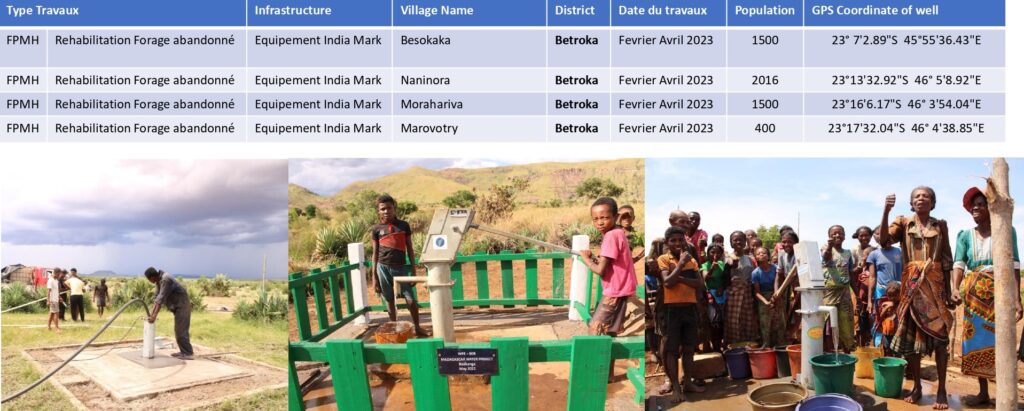
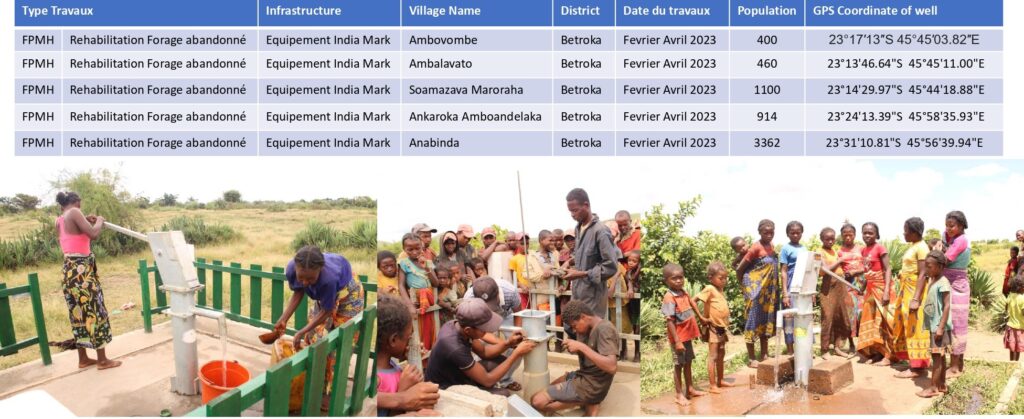
With growing visibility, we’re receiving partnership requests and inquiries, enabling us to make a meaningful impact. Without the support of donors, much of this progress wouldn’t be possible, especially in remote villages where aid is scarce.
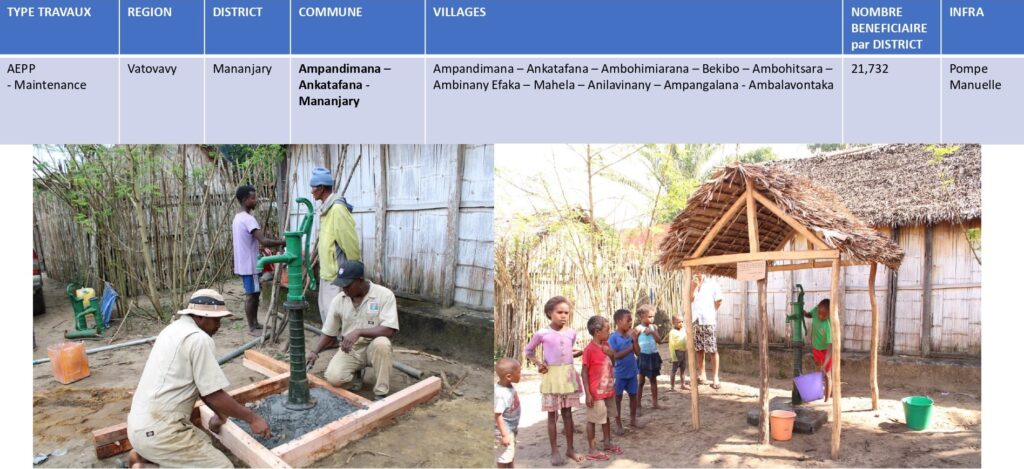
Looking ahead to our 2024 Program, we’ll address the persistent water challenges in Northwest Madagascar. Our commitment remains strong in Southern Madagascar, where we rehabilitate abandoned wells and establish new ones.
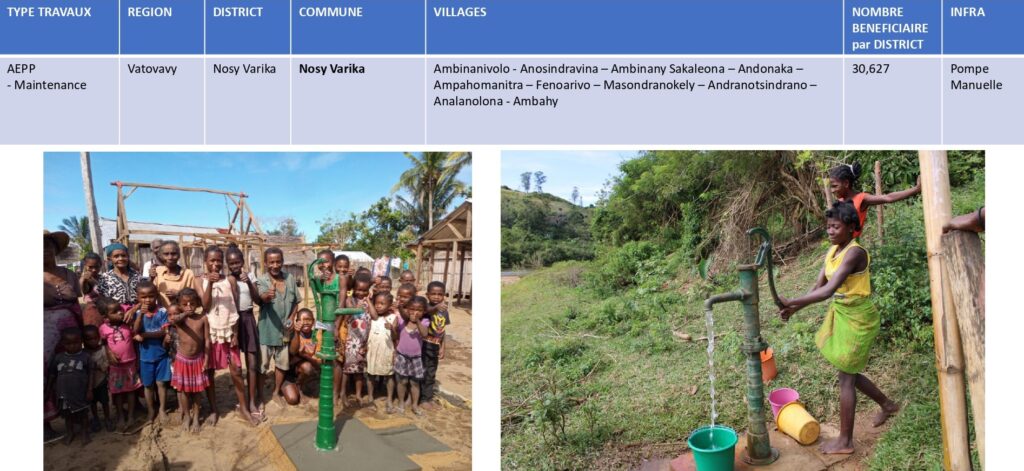
Recently, our Malagasy Team found over 80% of wells operational after a maintenance trip, showcasing our dedication to ongoing support. Through the Water for Everyone Program (WFE), we identify and address needs in remote villages, supported by matching grants and guidance from Water Charity.
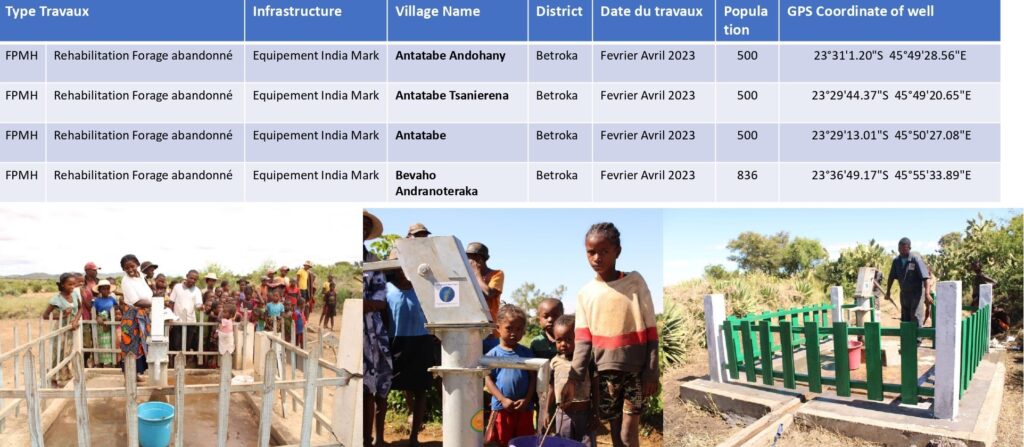
Our flagship project for 2023 is the Marolambo Water Rehabilitation Project, aiming to provide clean water to 7,763 people. Marolambo, with a population of 30,000 lacking clean water access, highlights the urgency of our work. Our largest project to date seeks to revitalize the municipal water system, benefiting not only Marolambo but also neighboring villages.
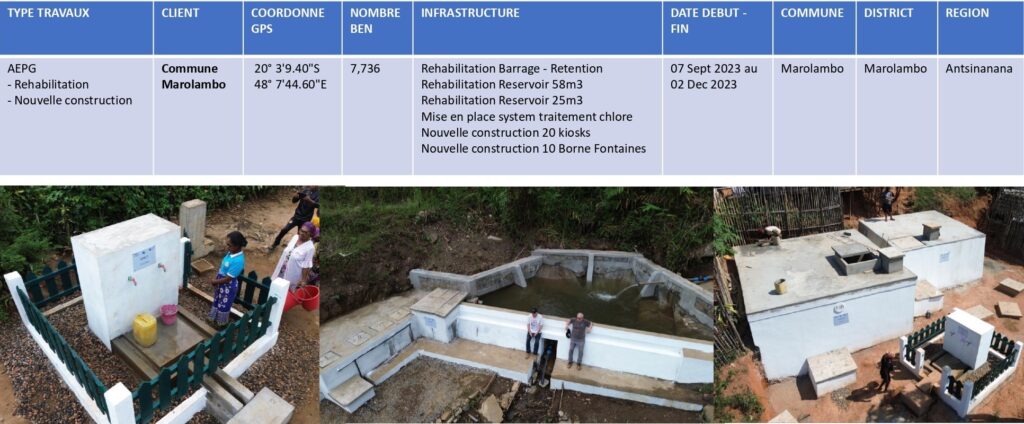
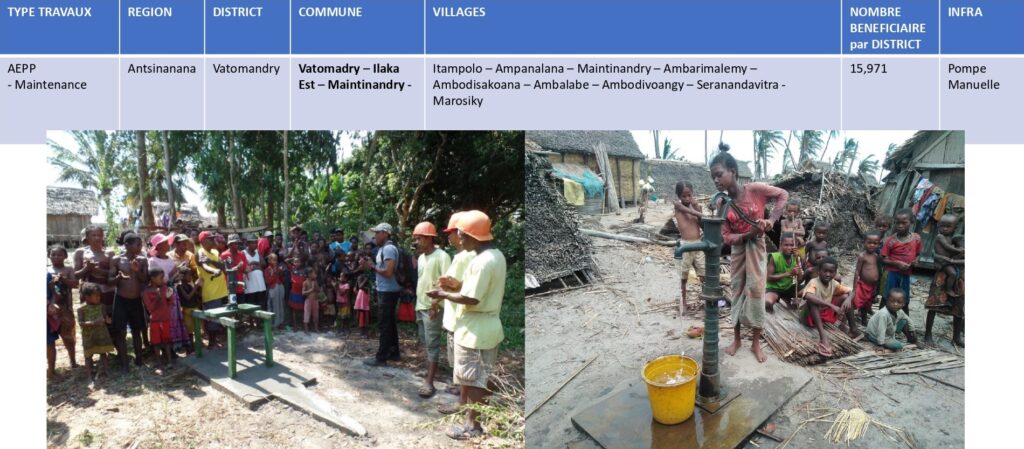

Additional Update
The team in Madagascar recently suffered a loss as Mia, their dedicated Driver for four years, passed away tragically due to injuries from an altercation in Antananarivo. Despite language barriers, Mia navigated challenges with remarkable teamwork, demonstrating his readiness to confront any obstacle. His unique character and unwavering dedication will be deeply missed by the team. He is the guy in the middle.

As part of Water Charity’s partnership with MWP in the Water For Everyone – Madagascar Program, we have agreed to match all contributions 100% (up to $100k). This is a great opportunity to double your impact. Your donation using this Donate button will ensure that we have funds available to accomplish this program.